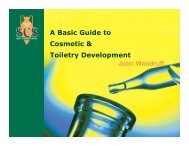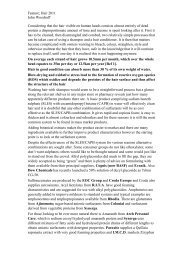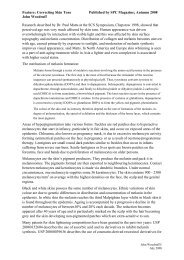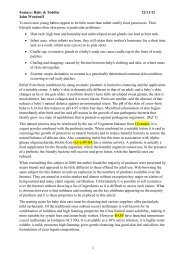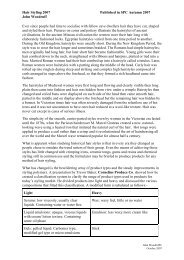Surfactants 2012 - Creative Developments
Surfactants 2012 - Creative Developments
Surfactants 2012 - Creative Developments
You also want an ePaper? Increase the reach of your titles
YUMPU automatically turns print PDFs into web optimized ePapers that Google loves.
Feature; <strong>Surfactants</strong>1<br />
John Woodruff<br />
Introduction<br />
An essay question set by the Society of Cosmetics Scientists (UK) in its prestigious<br />
Distance Learning Course started “Arguably surfactants are the single most important<br />
class of compounds found in cosmetics”. It is a statement that is difficult to dispute as<br />
they are used as cleansing and foaming agents, emulsifiers and solubilisers, for<br />
wetting and dispersal of pigments and for skin and hair conditioning. They may have<br />
antimicrobial properties, add emolliancy; modify product rheology and impart texture<br />
and feel to product compositions.<br />
This feature is going to focus on mild surfactants used in personal cleansing<br />
formulations and on some of the more recently introduced emulsifiers and solubilisers<br />
and will also suggest thickening aids for systems that do not respond well to the<br />
addition of electrolytes.<br />
Mild <strong>Surfactants</strong> for Personal Care<br />
Shower gels and body washes are invariably based on surfactants and the well<br />
established combination of sodium laureth sulphate [SLES] with cocamidopropyl<br />
betaine [CAPB] is still that in most common use. However for more expensive brands<br />
with claims to extra mildness, creamier foams and other positive attributes there are<br />
many more materials to investigate. The pursuit of more mild compositions may have<br />
been stimulated by a paper by Peter Dykes published in the International Journal of<br />
Cosmetic Science [IJCS] [Ref 1] in 1998.<br />
In it Dykes described the effects of surfactants on the skin and wrote that when we<br />
clean the skin we remove not only the bacteria, dirt and grease which have<br />
accumulated, but also part of its natural barrier, the stratum corneum. Corneocytes,<br />
both singly and in clumps, are released from the skin surface by the action of<br />
detergents and mechanical stimulation. So too are the lipids and proteins which make<br />
up the inter-corneocyte region of the stratum corneum Dykes continued, changes in<br />
the physical properties of skin occur after washing, for example, changes in skin<br />
surface pH and transepidermal water loss (TEWL) are easily demonstrable. Also<br />
excessive exposure to surfactants results in repeated damage to the stratum corneum<br />
which can in turn lead to an irritant dermatitis.<br />
In the pursuit of foam, which the majority of users perceive as a desirable product<br />
property, it is easy to overlook that when the bubbles are first formed they are<br />
spherical. There is enough space between each individual bubble for the presence of<br />
the surfactant-containing liquid, and the foam behaves like an emulsion and feels wet.<br />
However as the bubbles age the liquid drains from them and they assume a hexagonal<br />
shape, these bubbles are unstable and soon collapse. There is little liquid within the<br />
bubble walls and they have little wetting ability.<br />
When formulating foaming products it is necessary to remember that sufficient<br />
wetting occurs only if the surfactant-containing liquid can drain from the foam to<br />
contact the skin, and drainage can occur only if the foam bubbles are spherical.<br />
Shampoos require a quick transition from spherical to hexagonal so that they can be<br />
readily rinsed away; shower gels need to be stable for two minutes or more while the<br />
user massages the product onto the skin and shave creams need to last the length of<br />
the wet shaving process.<br />
1
Feature; <strong>Surfactants</strong>2<br />
John Woodruff<br />
The Cornelius Group has produced an interesting PowerPoint presentation [Ref 2]<br />
that shows micrographs of various foams produced by commonly used surfactants and<br />
how their stability can be controlled by the addition of certain surfactants from RITA.<br />
Because of its excellent foaming characteristics an 8% solution of sodium lauryl<br />
sulphate was used as the bench mark and comparable foams were produced using a<br />
blend of 0.8% acyl lactylate with 7.2% cocamidopropyl betaine. RITA claims that the<br />
addition of short-chain acyl lactylates results in high volumes of foam that remain<br />
stable for an extended time period and it is mild and biodegradable.<br />
As well as the individual acyl lactylates RITA also supplies surfactant blends of<br />
various lactylates with cocamidopropyl betaine, decyl glucoside and various anionic<br />
surfactants. Supplying blends is becoming an increasingly popular method for<br />
suppliers to turn commodities into specialities, which are appreciated by users. They<br />
provide optimum mixtures for specific applications; mean holding less material<br />
inventory and avoid minimum order problems for lesser used ingredients.<br />
Thus Rhodia supply Miracare SLB365 as a blend of sodium trideceth sulphate with<br />
cocamide MEA and sodium lauramphoacetate that make it possible to produce stable<br />
body washes with up to 30% oil content. It can support exfoliants and incorporate<br />
silicone oils using a simple cold mix procedure, which produces spherulites that are<br />
stabilised by the addition of guar derivatives. In use the oil content is deposited onto<br />
the skin giving a superb emollient effect.<br />
The Stephenson’s Group takes blends even further by supplying finished product<br />
concentrates. The Duroclens range of concentrated cleansing ingredients is derived<br />
from natural oils that have been developed to help formulate rinse-off products. They<br />
can be readily diluted in water and the concentrates are compatible with typical<br />
surfactant systems like SLES and CAPB or they can be used as the sole cleaning<br />
agent in a formulation. Stephenson’s also market Durasoft polyglyceryl esters of<br />
natural oils that are water-soluble co-surfactants that may be added to shower gels to<br />
enhance foam and skin feel.<br />
Ajinomoto supply Amisoft CS-22, a blend of sodium cocoyl glutamate and disodium<br />
cocoyl glutamate as an ultra-mild anionic surfactant mix that imparts a pleasant<br />
moisturised skin feel without drying the skin. Ajinomoto is well known for its amino<br />
acid based surfactants such as sodium cocoyl glycinate, sodium cocoyl alinate and<br />
various glutamates. Amisoft ECS-22SB [INCI: Disodium cocoyl glutamate] is<br />
suggested as an extremely mild surfactant system for delicate baby skin. Also if used<br />
as a tertiary surfactant in combination with SLES/CAPB it significantly reduces<br />
irritation and helps the skin to remain moisturised.<br />
Sodium cocoyl glycinate is available as Hostapon SG from Chemlink and is a mild<br />
surfactant that gives a rich lather making it ideal for creamy body washes. Amino<br />
acids are also the basis of Liposine Glyglu/R from Maycos Italia, which is a lipoamino<br />
acid obtained by the acylation of coconut fatty acids with amino acids from<br />
rice. This interaction forms a lipo-amino acid complex with cleaning and foaming<br />
properties. The foam obtained is creamy, fine and stable and the product is very mild<br />
to the skin.<br />
Taurates are an alternative to alkyl ethoxylated sulphates and claim mildness and<br />
good foaming properties. Nikko Chemicals supply sodium N-cocoyl-N-methyl<br />
2
Feature; <strong>Surfactants</strong>3<br />
John Woodruff<br />
taurate as a 30% aqueous solution. It is trade named CMT-30 and Nikko claim that by<br />
minimising the salt level and by careful control of the alkyl chain in manufacture it is<br />
possible to make low viscosity shampoo and cleansing preparations that are clear and<br />
have excellent foaming characteristics.<br />
It is difficult to find a more cost effective surfactant for foaming products than SLES<br />
and provided it is not excluded from use for marketing reasons there are many ways<br />
of reducing its negative effects while enhancing its performance and foaming<br />
properties. As an example Kalichem Italia suggest Olivoil Avenate Surfactant [INCI:<br />
Potassium olivoyl hydrolyzed oat proteins] as a poly-functional surfactant with mild<br />
cleansing power and emollient properties. It may be used alone in ultra-mild<br />
compositions or in conjunction with SLES to substantially reduce TEWL following<br />
showers and personal cleansing. Its structure is a balanced combination of whole<br />
lipids from olive oil and oat proteins.<br />
Also from Kalichem and recommended for use in conjunction with conventional<br />
anionic surfactants is Olivoil PCa which is said to provide the skin with the<br />
moisturising effect of PCA with the benefits of the unsaturated fatty acids from olive<br />
oil. It is claimed that Olivoil PCA provides the skin with smoothness, a reduction of<br />
TEWL and renovation of the normal barrier function of skin. Another product range<br />
that adds exceptional smoothness when incorporated in shower gels are the Polyox<br />
high molecular weight polyethylene glycols from Amerchol-Dow.<br />
Co-surfactants in cleansing compositions are usually either amphoteric like CAPB or<br />
non-ionic. Non-ionic surfactants are favoured because they are generally very mild to<br />
the skin and moderate the irritation and excessive cleaning that can be experienced<br />
with conventional anionic surfactants. Levenol H&B is a glycerine polyoxyethylene<br />
ester from Kao, [INCI: Glycereth-2 cocoate]. Described as a multifunctional and<br />
versatile non-ionic co-surfactant. it performs as a thickener and foam booster in rinseoff<br />
cleansers. Because it is a glycerine ester it has good skin conditioning and<br />
moisturising properties. Respharma markets the water-soluble olive oil polyglyceryl-<br />
4 esters as Resplanta PGF Olea with similar properties of foam boosting and skin<br />
conditioning.<br />
Inulin obtained from chicory is the source material for two materials from Beneo.<br />
Inutec H25 is inulin itself and Inutec SP1 is inulin lauryl carbamate and both can be<br />
regarded as co-surfactants that improve foam texture and skin feel. Formulations<br />
incorporating these materials show excellent foaming even when containing up to<br />
10% oils.<br />
A product with cationic properties and compatible with anionic surfactants is<br />
Vegequat from Sinerga. It is a 30% solution of cocodimonium hydroxypropyl<br />
hydrolyzed wheat protein formed by the condensation of coconut fatty acids with<br />
hydrolyzed wheat protein. Although it’s principal application is in conditioning<br />
shampoos it can also be used in creamy body washes. Another product with cationic<br />
conditioning properties that is compatible with anionic surfactants is Silplex J2S from<br />
Siltech [INCI: Silicone Quaternary-20]. It is a water-soluble cationic silicone/anionic<br />
silicone complex that gives outstanding conditioning to skin and hair..<br />
Whatever the cosmetic product category it is almost impossible to avoid siliconebased<br />
materials. Shower gels are no exception and Koda supply a number of<br />
3
Feature; <strong>Surfactants</strong>4<br />
John Woodruff<br />
polyethylene glycol modified silicones under its Hydrosil trade name. They are<br />
described as new and unique silicone urethane oligomers and are compatible with<br />
other silicone-based products and are readily soluble in water based formulations,<br />
adding lubricity and foam stability. They also show outstanding wetting properties for<br />
pigments and powders and 3-6% in water successfully wets fluoro-coated pigments<br />
and inorganic sunscreen actives, thereby aiding in their dispersal.<br />
The principal use of silicones in surfactant compositions is in 2-in-1 shampoos but<br />
suspension of the silicone and achieving significant deposition onto the hair has<br />
always been a problem. An article in the IJCS [Ref 3] describes an increase in the<br />
deposition efficiency of silicone conditioning actives from a shampoo on colourtreated<br />
hair via liquid crystal colloidal structures, created with polyquaternium-6 and<br />
negatively charged surfactants such as ammonium lauryl sulphate and ammonium<br />
laureth-3 sulphate. This approach may be worth considering as a way to deposit<br />
silicones from shower products.<br />
Emollients other than silicone are also incorporated in surfactant systems to improve<br />
skin feel and this is the theme of a paper by A. Mehling published in the same journal<br />
[Ref 4]. In this study, the effects of various tripartite systems consisting of SLES, a<br />
co-surfactant and an emollient were studied. The two different emollients tested;<br />
dibutyl adipate and a methylpropanediol monoester, adsorbed in varying amounts<br />
although the same surfactant/co-surfactant system was used. It was found that the<br />
deposition of both SLES and/or the emollient was also substantially influenced by the<br />
emollient component itself as well as by the co-surfactant used. Sensory assessments<br />
showed that although SLES has a negative effect on skin feel, adsorbed emollients<br />
improve skin softness and smoothness. Mehling concluded that the results show that<br />
optimisation of performance is possible when using a co-surfactant best suited for the<br />
emollient.<br />
An emollient blend recommended for adding to shower gels is Nipseal PP21 from<br />
Brasca. It is a mix of C9-15 alkane with hydrated silica and polyquaternium-2 that is<br />
claimed to add skin feel and moisturising properties to the formulation. Amisol Trio<br />
from Lucas Meyer is a blend of phospholipids, glycine soja, glycolipids and glycine<br />
soja sterols that can be added to shower gels at 0.3% to reduce TEWL and improve<br />
skin hydration. Also from Lucas Meyer Detoxium is a mix of magnesium salts from<br />
sea water with phospholipids and stearoyl inulin, suggested as an additive for shower<br />
gels<br />
Solubilising Perfumes and Essential Oils<br />
Dissolving oils in water for such products as skin toners is difficult; made more so if<br />
the market does not want ethoxylated compounds, and various solubilising agents<br />
have been proposed to overcome the problem. Sinerger suggest Natisol [ INCI:<br />
Cocoyl proline] for dissolving perfumes and essential oils. Lonza has the Polyaldo<br />
series of surfactants which are worth consideration; they are polyglyceryl-10 oleate<br />
and polyglyceryl-10 stearate. Sisterna L70-C is sucrose laurate in 40%<br />
aqueous/alcohol solution with good perfume solubilising properties.<br />
Croda suggests the use of NatraGem S140 and NatraGem S150 as highly efficient<br />
natural solubilisers with counter-irritancy benefits. S140 is polyglyceryl-4<br />
laurate/sebacate with polyglyceryl-6 caprylate/caprate and S150 is polyglyceryl-4<br />
4
Feature; <strong>Surfactants</strong>5<br />
John Woodruff<br />
laurate/sebacate with polyglyceryl-4 caprylate/caprate, each in aqueous solution. The<br />
S140 is particularly effective for solubilising essential oils and a solubility table is<br />
available through Croda.<br />
Symbio Sollv XC from Dr Straetmans is a PEG-free multi-component mixture of<br />
caprylyl/capryl wheat bran/straw glycosides, fusel wheat bran/straw glycosides,<br />
polyglyceryl-5 oleate, sodium cocoyl glutamate and glyceryl caprylate in aqueous<br />
solution recommended for solubilising perfumes and essential oils. Natpure SOL from<br />
Sensient Technologies is a mixture of sucrose esters that are all made from materials<br />
of natural origin. It has a combined HLB of 15.5 and shows outstanding solubilising<br />
properties, which are confirmed by many examples in its brochure.<br />
Thickening Surfactant Systems<br />
The viscosity of traditional anionic surfactant systems responds well to the addition of<br />
electrolytes and can be thickened to the desired level, even to a gel structure. However<br />
many of the surfactants described in this article do not respond to added salt and<br />
alternative systems are necessary. PEG-150 stearate is frequently used but its shearthickening<br />
rheology is often a disadvantage. Other traditional thickeners include<br />
xanthan gum, carrageenan and various cellulose derivatives and there are many grades<br />
of these materials, each with different rheology profiles.<br />
Guar derivatives also come under the heading of traditional rheology modifiers and<br />
are well known as hair conditioning agents but they are also useful for thickening<br />
difficult surfactant systems such as those based on amphoacetates. Rhodia supply a<br />
number under the Jaguar label and Jaguar C162 [INCI: Hydroxypropyl guar<br />
hydroxypropyltrimonium chloride] is worth consideration.<br />
Versathix from Croda is an aqueous solution of PEG-150 pentaerythrityl tetrastearate<br />
with PPG-2 hydroxyethyl cocamide and described as an exceptionally versatile<br />
rheology modifier that provides viscosity building across a wide variety of surfactant<br />
systems, with a neutral effect on foaming. It provides viscosity in traditional, as well<br />
as sulphate free systems, coupled with shear thinning rheology which is especially<br />
important in bath and shower gels<br />
More recent introductions are based on acrylate chemistry and Rheomer 33 from<br />
Rhodia [INCI: Polyacrylate-33] is a good example. It is a hydrophobically-modified<br />
alkali-swellable emulsion (HASE) polymer for personal cleansing solutions designed<br />
to provide efficient thickening with shear-thinning rheology and good suspension<br />
properties in low-to-medium surfactant systems.<br />
Another example of a hydrophobically modified polymer is Aristoflex HMB from<br />
Clariant. This ammonium acryloyldimethyltaurate / beheneth-25 methacrylate<br />
crosspolymer is a pre-neutralised thickening additive for surfactant systems. Aculyn<br />
28 by Dow is an acrylates/beheneth-25 methacrylate copolymer that is compatible<br />
with non-ionic and anionic surfactants and imparts pseudoplastic thickening to<br />
surfactant systems over a broad pH range.<br />
Ajinomoto has prepared a very interesting presentation [Ref 5] showing the viscosity<br />
response of N-acyl glutamate to the addition of glyceryl laurate in the presence of<br />
magnesium chloride. The rheological behaviour is dominated by the change in micelle<br />
shape; initially these are spherical but the addition of glyceryl laurate changes their<br />
shape to rods and then added magnesium chloride changes their shape to worm-like<br />
and finally liquid crystals are formed. Disodium cocoyl glutamate can be used to<br />
5
Feature; <strong>Surfactants</strong>6<br />
John Woodruff<br />
control rheology of SLES/CAPB systems and this is the subject of a second<br />
presentation [Ref 6].<br />
This article has focused on alternative surfactants to the traditional SLES/CAPB<br />
systems for use in personal care cosmetics. Many of them can form the basis of<br />
products for use in Spa treatments such as scrubs and bathing products with added<br />
benefits. This theme will be continued in the next issue.<br />
NOTE: Many of the materials named are Ecocert approved and where INCI names are<br />
given this is for the principal ingredients only. Those interested are advised to contact<br />
the supplier for more information.<br />
Ref 1 Dykes , P. (1998), <strong>Surfactants</strong> and the skin; Int. J. Cosmet. Sci, 20: 53–61<br />
Ref 2<br />
Acyl lactylate derivatives; The Cornelius Group<br />
Ref 3 Brown et al (2010), Liquid crystal colloidal structures for increased silicone<br />
deposition efficiency on colour-treated hair; Int. J. Cosmet. Sci; 32, 193–203<br />
Ref 4 A. Mehling et al (2010), Differential deposition of emollients from tripartite<br />
formulation systems; Int. J. Cosmet. Sci, 32, 117–125<br />
Ref 5 Novel facial wash formulation based on the technique of wormlike micelles in<br />
aqueous n-acyl glutamate systems; Ajinomoto Amino Science Laboratories; available<br />
through Rahn UK.<br />
Ref 6 Rheology control using viscoelastic surfactant solutions; Ajinomoto Amino<br />
Science Laboratories; available through Rahn UK.<br />
John Woodruff<br />
www.creative-developments.co.uk<br />
6






